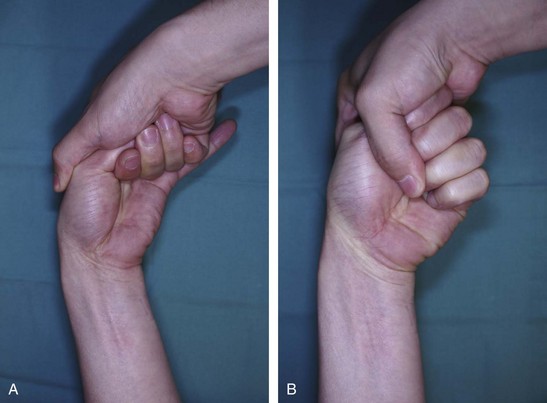Procedure 6 Surgical Treatment of de Quervain Tendovaginitis
![]() See Video 3: Release of First Dorsal Compartment for de Quervain Tendovaginitis
See Video 3: Release of First Dorsal Compartment for de Quervain Tendovaginitis
Examination/Imaging
Clinical Examination
 The patient has tenderness over the radial styloid and may have triggering of the thumb extensor tendons. The following two tests can be done to confirm the presence of de Quervain disease.
The patient has tenderness over the radial styloid and may have triggering of the thumb extensor tendons. The following two tests can be done to confirm the presence of de Quervain disease.
 The examiner must evaluate for and rule out other causes of radial wrist pain. They include thumb basal joint arthritis, scaphoid fracture, Wartenberg syndrome (compression of the superficial sensory branch of the radial nerve between the extensor carpi radialis longus [ECRL] and brachioradialis [BR]), intersection syndrome (tendinitis at the crossing over of the APL and EPB muscle bellies over the ECRL and extensor carpi radialis brevis [ECRB]), scaphotrapeziotrapezoid (STT) arthritis, and Preiser disease (avascular necrosis of the scaphoid).
The examiner must evaluate for and rule out other causes of radial wrist pain. They include thumb basal joint arthritis, scaphoid fracture, Wartenberg syndrome (compression of the superficial sensory branch of the radial nerve between the extensor carpi radialis longus [ECRL] and brachioradialis [BR]), intersection syndrome (tendinitis at the crossing over of the APL and EPB muscle bellies over the ECRL and extensor carpi radialis brevis [ECRB]), scaphotrapeziotrapezoid (STT) arthritis, and Preiser disease (avascular necrosis of the scaphoid).
Surgical Anatomy
 Six extensor compartments have been described over the dorsum of the wrist (Fig. 6-3A).
Six extensor compartments have been described over the dorsum of the wrist (Fig. 6-3A).
 The first dorsal compartment is involved in de Quervain tendovaginitis. It contains two tendons, the APL and the EBP (Fig. 6-3B and C). The APL tendon has multiple slips. The APL tendon is more radial and volar, whereas the EPB tendon is ulnar and dorsal. In up to 40% of subjects, there may be a separate subsheath for each of the two tendons.
The first dorsal compartment is involved in de Quervain tendovaginitis. It contains two tendons, the APL and the EBP (Fig. 6-3B and C). The APL tendon has multiple slips. The APL tendon is more radial and volar, whereas the EPB tendon is ulnar and dorsal. In up to 40% of subjects, there may be a separate subsheath for each of the two tendons.
Stay updated, free articles. Join our Telegram channel

Full access? Get Clinical Tree







